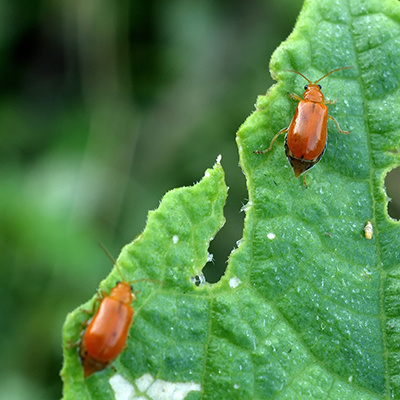How to Get Rid of Japanese Beetles

Last updated March 22, 2024
Japanese beetles are invasive pests that may visit your garden in summer months. USDA classifies Japanese beetles as a destructive plant pest that eats leaves, flowers and fruit in home landscapes, as well as commercial agricultural crops.
Japanese beetles cause destruction throughout their life cycle. Beetle grubs damage lawns and adult Japanese beetles destroy plants. Successfully treating Japanese beetle infestations can involve several methods.
In this guide, learn how to identify and how to get rid of Japanese beetles.
Difficulty:
Beginner
Duration:
Under 2 hours
Table of Contents
How to Identify Japanese Beetles
Spray for Japanese Beetles
Hand Pick Japanese Beetles
Consider Traps to Control Japanese Beetles
More Japanese Beetle Treatments
When to Call a Professional
How to Identify Japanese Beetles

Japanese beetle adults are distinctively colored insects. They are about 1/3 to ½-inch in length. The head and thorax are metallic green and covered with copper-brown wings. They have white hair on the sides and tips of their abdomens.
Japanese beetle larvae are C-shaped white or cream-colored grubs with tan heads. They are 1/8 to 1-inch in length. (Grubs of insect species tend to look alike. For a definitive i.d., check with your local Extension office.)
Japanese beetle grubs eat grass roots. This reduces the ability for grasses to take up water. Homeowners typically identify Japanese beetle grub infestations by patches of dead grass in the landscape.
Japanese beetle adults live for about two months in the heat of the summer. Adults emerge from the ground when temperatures reach 70 degrees Fahrenheit and start to feed on your landscape plants. Populations peak in mid-summer and can last until temperatures cool in September.
Once you have a few Japanese beetles on your plants, be aware that you may soon have more. Japanese beetles release an aggregation pheromone that signals more beetles to join the feeding frenzy. This is why it’s a good idea to scout for pests and to manage Japanese beetles as soon as you see them in your garden.
Japanese beetles “skeletonize” leaves by chewing the plant tissue in between the veins in leaves. The decimated leaves then turn brown and drop. Beetles' consistent feeding damages the flower and fruit production of your plants.
The good news is that Japanese beetle infestations are typically short-lived. The insects do their damage then move on, giving plants opportunity to recover for the remainder of the season.
One strategy to control Japanese beetles is to maintain a healthy lawn and garden that can tolerate some grubs and beetles. Healthy lawns need about an inch of water each week, either from irrigation or rain. Give grass an opportunity to build strong roots. Re-seed, aerate and de-thatch in spring and fall for a lush, healthy lawn.
Catch Japanese beetle damage early when you routinely scout your garden. This means walking through your landscape, turning over leaves, inspecting flowers and foliage for signs of insect or disease damage. Quite often, you'll identify beneficial insects and manageable damage to plants. When you encounter Japanese beetles, the first strategy is to gently pick off the insects and drop them into a bucket of soapy water to drown them.
Spray for Japanese Beetles

You can control Japanese beetles via organic strategies like removing by hand. The damage is often short-lived because the beetles will move on to another garden and most plants quickly recover.
There are natural and organic options for Japanese beetle treatments. If beetle grubs in soil are a problem, you can use a product like milky spore, the common name for bacterium bacillus popillae. To use this lawn treatment for Japanese beetles, spread the powder over soil, and it will kill developing Japanese beetle larva. Milky spore will not harm beneficial insects and is safe to use around pets and wildlife.
Mix up neem oil for an organic spray for Japanese beetles. Neem oil is an organic treatment for use on roses, fruits, vegetables and other plants affected by Japanese beetles. Neem oil kills eggs, larvae and adults. You can use it in your lawn to treat Japanese beetle grubs and spray it on plants affected by Japanese beetles. Neem oil is available in a ready-to-use spray bottle. You can purchase a concentrated Neem oil that you mix up in a spray bottle or pump sprayer to treat affected plants.
Hand Pick Japanese Beetles

The most effective method of Japanese beetle control for your home landscape is to hand pick the pests from your plants.
To hand pick Japanese beetles, first scout in your garden as part of your weekly routine. This is good gardening practice to discover pests and diseases before they become a problem. In mornings or evenings, walk through your garden and turn over leaves, inspecting plants for signs of damage.
When you spy Japanese beetles, bring a bucket of soapy water into the garden with you. Wear gardening gloves and remove the beetles by hand, dropping them into the soapy water to drown them. Dispose of the water outside.
Tip: Take pruning snips into the garden with you and remove heavily damaged stems and branches.
Consider Traps to Control Japanese Beetles

Japanese beetle traps are a popular way to trap the pesky insects. They act by luring Japanese beetles away from ornamental flowers, trees and shrubs. The traps are colored bright yellow and lure the beetles with pheromones and a floral lure. For the most success, locate traps about 30 feet downwind of your plants to intercept the beetles before they get to your garden. Setting up Japanese beetle traps on the perimeter of your property may be an effective strategy. Japanese beetle traps need to be frequently emptied so that they don’t overflow with the pests that will then find your tasty garden plants.
Traps are useful to determine if you have a problem with Japanese beetles. You may set up the trap and the bag fills quickly; or you set up the trap and capture only a few. This may be an indicator of your overall Japanese beetle problem.
Tip: Traps are most effective when Japanese beetle populations are active. Do not leave Japanese beetle traps up throughout the year, only during summer.
More Japanese Beetle Treatments

Aside from traps and sprays, you can protect your plants from Japanese beetles with row covers and netting. However, row covers can interfere with pollination. If you're covering fruit trees or flowers, hand pick pests until flowers or fruit form, then cover to protect.
Long term, the best strategy is to fill your landscape with plants that Japanese beetles don’t like. Experienced gardeners call this strategy Right Plant, Right Place. These plants include:
- Boxwood
- Chrysanthemum
- Clematis
- Conifers
- Daylily
- Forsythia
- Geranium
- Ginkgo
- Lilac
- Magnolia
- Red and silver maple
- Oak
- White poplar
- Redbud
- Rhododendron
- Yew
In addition to the gardener’s golden rule of Right Plant, Right Place, follow organic practices for a healthy garden that is able to resist pest and disease problems. These practices include building up healthy soil and routinely scouting for pests on your plants.
Keep trees and shrubs healthy by pruning out diseased branches, nourishing the soil with organic matter, and watering during extreme heat.
Tip: Keep rotting or diseased fruit off your trees. The fruit will attract insects like Japanese beetles.
When to Call a Professional

Sometimes, strategies like hand-picking Japanese beetles from your plants aren't enough. You may have a food or cut flower crop that's affected by the pests. If the scale of the problem can't be managed by the strategies outlined here, you may need to consult professionals to manage your Japanese beetle problem.
Remember to consider your community when managing pest problems, and especially Japanese beetle populations. Talk with your neighbors about strategies to alleviate Japanese beetles and coordinate on setting traps and using organic solutions before calling professional pest control companies.
Looking for the supplies you need to manage your garden and control Japanese beetles? The Home Depot delivers online orders when and where you need them.



























